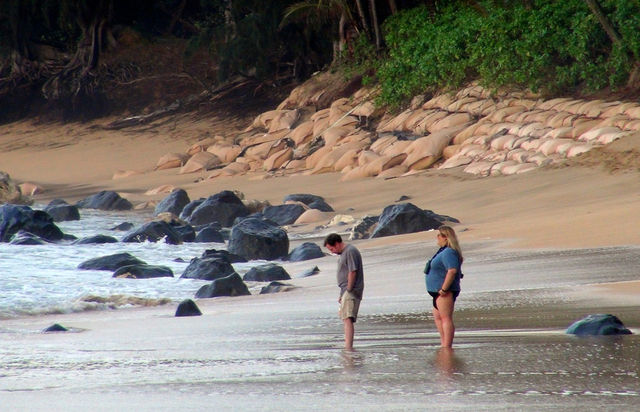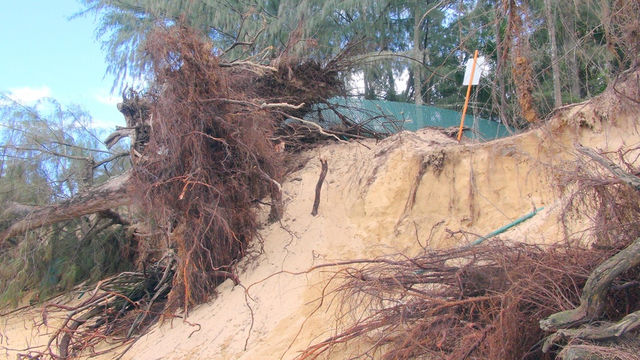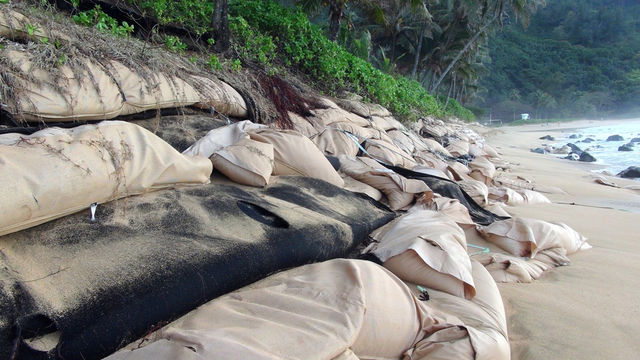HANALEI — Mix seasonal changes with chronic erosion, dash in some global warming, coral death and rise in sea level, and top all of that with one mean El Nino year — and you’ve got a cocktail of challenges for
HANALEI — Mix seasonal changes with chronic erosion, dash in some global warming, coral death and rise in sea level, and top all of that with one mean El Nino year — and you’ve got a cocktail of challenges for Kauai’s coastline.
One example of the damage can be seen at Tunnels Beach, which has been losing about a foot of sand annually, according to Hanalei biologist Terry Lilley, who has been monitoring the beach since 2012.
“This year, due to constant giant surf, much of the beach at Tunnels has lost its sand,” Lilley said. “We will have to wait to see if it comes back, but at the current rate of coral death and rising sea levels, I am sure Tunnels will not have any beach whatsoever in 10 years or less.”
Lilley said research is still being done to discover the cause of the coral reef’s death at Tunnels.
He said, though, that it is directly contributing to the coastal erosion because the corals drag on the underside of the wave, making the wave break on the reef and not on the beach.
“The loss of the coral has caused an accelerated rate of erosion,” Lilley said.
Chip Fletcher, coastal geologist with the University of Hawaii, said if the death of the reef is rapid enough that it could lower the sea floor, more wave energy would hit the shoreline and that would lead to more chronic erosion.
“At the same time, the sand that is on the shore is made of the reef, so killing off the reef, we will decrease the amount of sand that goes onto the beach, too,” Fletcher said.
The reefs aren’t the only things that have a hand in Kauai’s coastal changes. Fletcher said it’s a combination of strong seasonal swells and a strong El Nino year as well.
He said climate models predict as the world grows warmer there will be larger El Ninos, and they will be more frequent. Those El Ninos will bring bigger waves to Kauai’s coastline and he said “they’ll be on the back of a rising ocean.”
Climbing temperature
Rising sea levels have to do with the rising temperature of the Earth — or global warming, according to Thomas Giambelluca, professor with the University of Hawaii’s geography department and acting associate director of the social science research institute.
He has been working with several Ph.D. and master’s degree students to study the effects of temperature rise on Hawaii.
NASA and the National Oceanic and Atmospheric Administration, for example, hailed February as the hottest month in all the years they’ve been recording the Earth’s temperature — 1.63 degrees Celsius above pre-industrial levels.
That takes global temperature for the month above the 1.5 degrees Celsius rise that last year’s Paris climate deal was supposed to prevent.
“The effect of global sea level rise is going to affect all of our coastlines,” Giambelluca said. “And the temperature can have an effect, along with ocean acidification by bleaching coral reefs, which means you’ll certainly open up more areas for more severe beach erosion.”
Erosion’s effects
Peter Sit, manager of Pono Kai Resort in Kauai, said he’s seen that erosion firsthand at the retaining wall that sits by the multi-use path, Ke Ala Hele Makalae, that runs near the resort.
The wall “has been there since the hurricane in ’92 and it’s just eroded through the years,” Sit said. “Part of the wall collapsed, so we’d been asking the county to do something to repair it.”
The $900,000 project was completed in December and Sit said he’s pleased with the way it turned out.
“They did a very good job. It was a dangerous situation and the pathway is public access right there,” Sit said. “It was a safety issue because the path was used quite a bit, but it’s been fixed.”
But Chuck Blay, a Kauai-based geoscientist who has been studying the seasonal sand shifting around Kauai for the past three years, said sea walls like the one near Pono Kai are actually part of the problem.
“It’s not just global climate change and sea level rise,” Blay said. “It’s what the people are doing. It’s the sea walls, the resorts built down to the shorelines, those things that block the beach as it wants to move.”
Sands on Kauai’s beaches traditionally move around, Blay explained. The sand at Kekaha Beach, for example, comes from Haena, and all of the Eastside beaches swap sand seasonally.
“It can’t go where it normally goes, so it goes somewhere else, maybe somewhere where nobody cares,” Blay said.
Building on a shifting island
According to Ka’aina Hull, regulatory planning chief, the County of Kauai takes coastal erosion into account when officials are issuing building permits, requiring an extra 20 feet in their setback rules.
Those setbacks are directly based on shoreline location.
In order to build a structure near Kauai’s shorelines currently, the property owner has to get a certified shoreline assessment from a certified coastal geologist and the Department of Land and Natural Resources within 12 months of building.
According to state law, the shoreline is the highest wash of the wave, not counting storm events, Hull explained, and so surveyors walk the coastline and together come up with the starting point of the setback.
State law says you can build 20 feet away from the set-back. Kauai County requires a minimum distance of 60 feet from the shoreline for most sandy coastal areas, and 40 feet from the rocky shorelines in order to build. Hull explained those are the minimum distances for set-backs and those distances can be further, some around 100 feet, depending on the conditions of the property.
“The shore setback, that was drafted primarily to address coastal erosion and folded into the setbacks is talk about global warming and sea level rise,” Hull said.
Hull said there haven’t been any studies and there’s no specific data that speaks to what Kauai will look like in the near future when it comes to sea level rise and global warming, but he said Fletcher is currently studying that.
“There’s opportunity for us to go back and incorporate that sea level rise data into the ordinance,” Hull said. “We know what’s happening, we just don’t have the specific data yet.”




